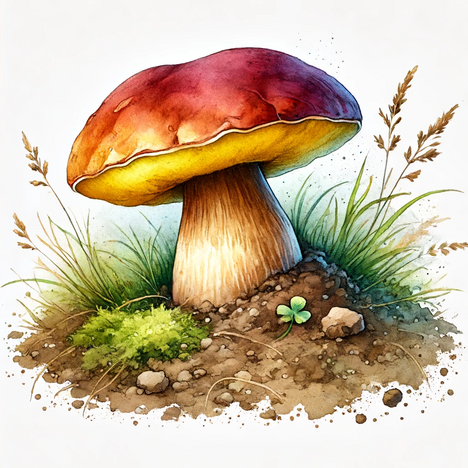Satanic boletus

Fungi fascinate us with their diversity, their unique ways of life and their importance in ecosystems. However, not all mushrooms are friends of humans or our animal companions. One particularly notorious representative is the Satanic boletus, whose name alone inspires respect. But what exactly is behind this mysterious mushroom and what are its effects on dogs? This article takes a closer look at the Satanic mushroom, examines its properties and explores the question of whether it poses a risk to our four-legged friends or may even offer unexpected benefits.
What is Satan's bolete?
The Satan's bolete (Boletus satanas) is a mushroom that belongs to the boletus family. With its characteristic, often light to whitish stem and the typical red to brown-red underside of the cap, it can be distinguished from other boletes. It grows predominantly in deciduous forests near oaks and beeches and is mainly found in Europe. Although its name suggests that it is a highly dangerous mushroom, the Satanic bolete is actually less poisonous than is often assumed. Nevertheless, it should be avoided due to its potentially unpleasant effects on the human body.
Effects on dogs
Potential dangers
- Toxicity: Although not one of the deadliest mushrooms, the Satanic bolete contains toxins that can cause gastrointestinal discomfort. Dogs that consume parts of this mushroom may show symptoms such as vomiting, diarrhea, abdominal pain and lethargy.
- Danger of confusion: One of the greatest dangers is the possibility of confusing the Satanic boletus with other mushrooms that are more poisonous to dogs. Its characteristic features can be difficult to identify, especially for laypeople, which increases the risk of confusion.
Unexpected benefits?
- Ecological importance: While the Satanic bolete offers no known benefits to dogs directly, it plays an important role as part of the ecosystem. Mushrooms like the Satanic bolete contribute to the decomposition of organic material, promoting the health of the forests our dogs love to walk in.
- Awareness and caution: The attention that the Satanic bolete and other poisonous mushrooms require can encourage dog owners to be more aware of the environment in which their dogs play and explore. This awareness can help protect dogs from many dangers.
Precautions and recommended actions
- Supervision: Always keep dogs under observation in mushroom-rich areas and prevent them from eating unknown mushrooms.
- Knowledge: Knowledge of the local fungal flora can help to recognize and avoid potentially dangerous situations.
- Act quickly: If fungal poisoning is suspected, a veterinarian should be consulted immediately. Early treatment can be crucial.
The Satanic boletus is a fascinating mushroom that deserves respect due to its potential toxicity, but does not necessarily inspire fear. It poses a potential danger to dogs, especially due to the possibility of confusion with other, more poisonous mushroom species. However, by developing an awareness of the risks and taking appropriate precautions, dog owners can effectively protect their four-legged friends. Ultimately, respecting the Satanic boletus and other mushrooms serves to ensure the curiosity and well-being of our dogs on their adventures in nature.
If you notice any signs of hypersensitivity or poisoning in your dog, you should see your vet immediately. We are not a substitute for a vet, but we try to be as accurate as possible. Every dog reacts differently and we recommend you get a second opinion or consult your vet if in doubt.
Stay healthy and take good care of your four-legged friend!😊